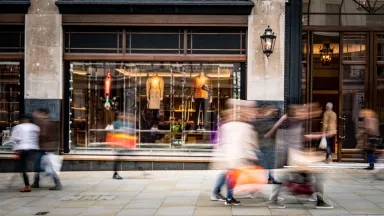Safety Concerns Could Influence Retail Performance This Holiday Season in the UK
New data shows that the majority (73%) of British consumers have expressed concern about their personal safety while shopping in person.
This concern isn’t unfounded. Not only is the rise in shoplifting and looting dominating headlines, but data also backs it up. The Office of National Statistics shows police-recorded crime in England and Wales is rising, and that those increases are in part a result of increases in theft offences against businesses, such as shoplifting, which are up 25% in the year ending June 2023 from the year before. The British Retail Consortium (BRC) also shows in its 2023 crime survey that incidents of violence and abuse towards retail workers have almost doubled compared with pre-pandemic levels.
This heightened sense of anxiety about personal safety while shopping, which Verkada found in a survey with the Harris Poll of more than 1,000 consumers across the UK, is having a profound impact on shopping behaviour – and is a wake-up call for retailers who want to bring back foot traffic in brick-and-mortar stores post-pandemic.
This concern among consumers is only growing with holiday shopping – traditionally the season with the highest foot traffic in stores – on the horizon. More than half of UK consumers (55%) say they are more concerned about their personal safety while shopping in person around the holidays this year than they were last year.
People are most worried about safety at shopping centers, which have already been struggling to get foot traffic back up post-pandemic.

Amid this rise in concern for personal safety, the majority of consumers in the UK (86%) have indicated that they are making a change in their holiday shopping behavior. The top three things they indicated that they will do are: shopping online for home delivery, being more selective about where they shop, and avoiding shopping during peak days/times.
Put together, these findings indicate that brick and mortar remains at risk unless retailers put stronger measures in place. Three ways retailers can take action today include:
Implementing deterrents. While security guards remain an important deterrent, current labor shortages have made security personnel increasingly scarce. Advanced systems integrating automated alarms and speakers with talk-down capabilities can make it easier for retailers of all sizes and scales to deter would-be thieves from carrying out crimes.
Providing staff with resources and training. It is critical for frontline retail employees to have the training and resources to respond to these events. Tools like panic buttons that are programmed to take action – whether it is alerting authorities or triggering a lock-down – help ensure that employees are able to take action swiftly. Importantly, training on how to respond in different scenarios and use these tools should be an ongoing commitment and not a one-time event.
Increasing visibility of anti-theft measures. It’s not just new technology like RFID tags or electronic article surveillance (EAS) tags that can help deter theft – locked display cases and altered store layouts can also make a difference.
By taking a multifaceted approach that incorporates the right mix of deterrents, employee training and new technology, retailers can safeguard the magic of the holiday shopping season that is around the corner.





